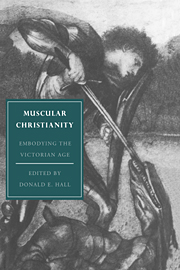Muscular Christianity: reading and writing the male social body
from INTRODUCTION
Published online by Cambridge University Press: 05 March 2010
Summary
The process of planning, building, and publishing this collection of essays has brought into dialogue a group of scholars from extraordinarily diverse critical and personal backgrounds. While chatting with contributors at a recent professional conference, I fielded questions ranging from a mildly, even sweetly, expressed, “So how long have you been interested in Christianity and literature?” to a much more archly inflected “So what exactly is it that you get out of Kingsley's novels?” Such is the body of fiction and nonfiction that serves as the focus of this collection. It elicits both reverence and ridicule, provides both “pure” and “perverse” forms of satisfaction, divergent reactions that exist not only among readers whose responses to texts depend upon unique interactions between critical, religious, political, and philosophical belief systems, but also, and just as commonly, within individual readers. How does an essay or novel provide what might be termed “guilty” pleasure? By pushing those buttons within our own psyches that we as intellectuals often deny possessing. In lives dominated by rigid teaching and writing schedules and consisting of hyper-conscious attention to our own thought processes, as well as those of our students and colleagues, we may find ourselves surprised, even embarrassed, by our racing heartbeat or smile of contentment when a brawny, self-confident hero triumphs handily over a menacing opponent.
My own engagement with Christian manliness or “muscular Christianity” (I will say more on terminology later) dates from the darkest days of graduate school when I was feeling particularly besieged by professional and financial worries and was hard at work on a project examining male anxiety in the novels of George Eliot.
- Type
- Chapter
- Information
- Muscular ChristianityEmbodying the Victorian Age, pp. 3 - 14Publisher: Cambridge University PressPrint publication year: 1994
- 16
- Cited by



